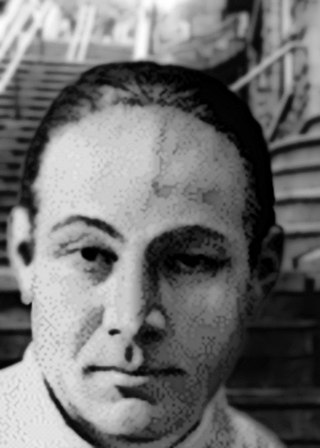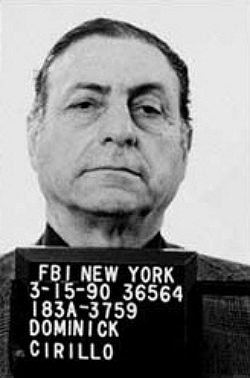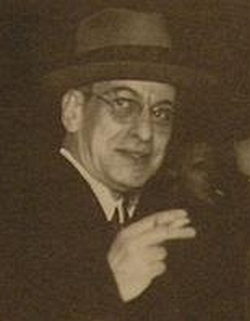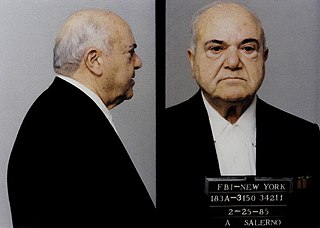
Carlo Gambino was a Sicilian-born American crime boss who was the leader and namesake of the Gambino crime family of New York City. Following the Apalachin Meeting in 1957, and the imprisonment of Vito Genovese in 1959, Gambino took over the Commission of the American Mafia and played a powerful role in organized crime until his death from a heart attack in 1976. During a criminal career that spanned over fifty years, Gambino served only twenty-two months in prison for a tax evasion charge in 1937.

Salvatore Maranzano, nicknamed Little Caesar, was an Italian-American mobster from the town of Castellammare del Golfo, Sicily, and an early Cosa Nostra boss who led what later would become the Bonanno crime family in New York City. He instigated the Castellammarese War in 1930 to seize control of the American Mafia, winning the war after the murder of rival faction head Joe Masseria in April 1931. He then briefly became the Mafia's capo di tutti capi and formed the Five Families in New York City, but was murdered on September 10, 1931, on the orders of Charles "Lucky" Luciano, who established The Commission, in which families shared power to prevent future turf wars.

Vincent Louis Gigante, also known as "Chin", was an American mobster who was boss of the Genovese crime family in New York City from 1981 to 2005. Gigante started out as a professional boxer who fought in 25 matches between 1944 and 1947. He then started working as a Mafia enforcer for what was then the Luciano crime family, forerunner of the Genovese family. Gigante was one of five brothers. Three of them, Mario, Pasquale, and Ralph, followed him into the Mafia. Only one brother, Louis, stayed out of the crime family, instead becoming a Catholic priest. Gigante was the shooter in the failed assassination of longtime Luciano boss Frank Costello in 1957. In 1959, he was sentenced to seven years in prison for drug trafficking, and after sharing a prison cell with Costello's rival, Vito Genovese, Gigante became a caporegime overseeing his own crew of Genovese soldiers and associates based in Greenwich Village.

Vito Genovese was an Italian-born American mobster of the American Mafia. A childhood friend and criminal associate of the legendary Lucky Luciano, Genovese took part in the Castellammarese War and helped Luciano shape the new American Mafia's rise as a major force in organized crime in the United States. He would later lead Luciano's crime family, which would in 1957 be renamed by the FBI as the Genovese Crime Family after its then boss Vito.
The Gambino crime family is an Italian-American Mafia crime family and one of the "Five Families" that dominate organized crime activities in New York City, within the nationwide criminal phenomenon known as the American Mafia. The group, which went through five bosses between 1910 and 1957, is named after Carlo Gambino, boss of the family at the time of the McClellan hearings in 1963, when the structure of organized crime first gained public attention. The group's operations extend from New York and the eastern seaboard to California. Its illicit activities include labor and construction racketeering, gambling, loansharking, extortion, money laundering, prostitution, fraud, hijacking, and fencing.
The Genovese crime family, also sometimes referred to as the Westside, is an Italian-American Mafia crime family and one of the "Five Families" that dominate organized crime activities in New York City and New Jersey as part of the American Mafia. The Genovese family has generally maintained a varying degree of influence over many of the smaller mob families outside New York, including ties with the Philadelphia, Cleveland, Patriarca, and Buffalo crime families.

The Five Families refer to five Italian American Mafia crime families that operate in New York City. In 1931, the five families were organized by Salvatore Maranzano following his victory in the Castellammarese War.

Thomas Gaetano Lucchese, sometimes known by the nicknames "Tommy", "Thomas Luckese", "Tommy Brown" or "Tommy Three-Finger Brown", was an Italian-American gangster and founding member of the Mafia in the United States, an offshoot of the Cosa Nostra in Sicily. From 1951 until 1967, he was the boss of the Lucchese crime family, one of the Five Families that dominate organized crime in New York City.

Thomas "Tommy Ryan" Eboli was a New York City mobster who eventually became the acting boss of the Genovese crime family.
Philip Lombardo also known as "Benny Squint" and "Cockeyed Phil", was the boss of the Genovese crime family from the late 1960s until the beginning of the 1980s. He succeeded Vito Genovese as Boss in 1969 and was succeeded by Vincent Gigante in 1981.

Dominick "Quiet Dom" Cirillo was a longtime high-ranking member of the Genovese crime family. Long holding allegiance to the family's Manhattan faction, Cirillo rose in power to caporegime, then briefly served as acting boss for imprisoned boss Vincent "Chin" Gigante, before stepping down to serve as consigliere.
Peter DeFeo, also known as "Philie Aquilino", was a New York mobster who became a caporegime with the Genovese crime family.
Vincent DiNapoli was a caporegime in the Genovese crime family, involved in labor racketeering. DiNapoli is best known for creating a cartel in the 1970s that controlled the price of drywall in New York City.

Anthony C. Strollo, also known as "Tony Bender", was a New York mobster who served as a high-ranking capo and underboss of the Genovese crime family for several decades.

Tino "T" Fiumara, also known as "The Greek," was a major figure in the Genovese crime family and was acting boss. Since the 1980s, he had been the leader of the Genovese New Jersey faction in northern New Jersey. After his final release from prison Fiumara lived on Long Island.
Mario "The Shadow" Gigante was an American mobster in New York City who served as a caporegime for the Genovese crime family. He was the elder brother of late family boss Vincent "The Chin" Gigante.
The 116th Street Crew, also known as the Uptown Crew, is a faction of the Genovese crime family. In the early 1960s, Anthony Salerno became the caporegime of the 116th Street Crew and one of the most powerful captains in the Genovese family. Salerno based the crew in the Palma Boys Social Club located at 416 East 115th Street in East Harlem, Manhattan. By the late 1970s and early 1980s, the 116th Street Crew had absorbed and initiated many former members of the vicious East Harlem Purple Gang, an Italian-American murder for hire and drug trafficking gang operating in 1970s Italian Harlem and acting generally independently of the Mafia.
The Lucchese crime family is an Italian-American Mafia crime family and one of the "Five Families" that dominate organized crime activities in New York City, within the nationwide criminal phenomenon known as the American Mafia. Members refer to the organization as the Lucchese borgata; borgata is Mafia slang for criminal gang, which itself was derived from a Sicilian word meaning close-knit community. The members of other crime families sometimes refer to Lucchese family members as "Lukes".

Dominick "Baldy Dom" Canterino was a caporegime in the Genovese crime family.

Anthony "Fat Tony" Salerno was an American mobster who served as underboss and front boss of the Genovese crime family in New York City from 1981 until his conviction in 1986.












